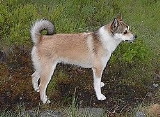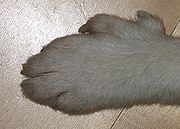
Norwegian Lundehund
Encyclopedia
The Norwegian Lundehund (Norsk Lundehund) is a small dog breed
of the Spitz
type that originates from Norway
. Its name is composed of the prefix Lunde, from the Norwegian lundefugl (puffin
), and the suffix hund, meaning dog. The breed was originally developed for the hunting of puffins and their eggs.
 The Norwegian Lundehund is a small, rectangular Spitz type dog. The Lundehund has a great range of motion in its joints, allowing it to fit into and extricate itself from narrow passages. Dogs of this breed are able to bend their head backwards along their own spine and turn their forelegs to the side at a 90-degree horizontal angle to their body, much like human arms. Their pricked, upright ears can be folded shut to form a near-tight seal by folding forward or backward. The Norwegian Lundehund is a polydactyl: instead of the normal four toes per foot, the Lundehund normally has six toes, all fully formed, jointed and muscled. Some specimens may on occasion have more or fewer than six toes per foot. The outercoat is dense and rough with a soft undercoat. The Lundehund is adapted to climb narrow cliff paths in Røst
The Norwegian Lundehund is a small, rectangular Spitz type dog. The Lundehund has a great range of motion in its joints, allowing it to fit into and extricate itself from narrow passages. Dogs of this breed are able to bend their head backwards along their own spine and turn their forelegs to the side at a 90-degree horizontal angle to their body, much like human arms. Their pricked, upright ears can be folded shut to form a near-tight seal by folding forward or backward. The Norwegian Lundehund is a polydactyl: instead of the normal four toes per foot, the Lundehund normally has six toes, all fully formed, jointed and muscled. Some specimens may on occasion have more or fewer than six toes per foot. The outercoat is dense and rough with a soft undercoat. The Lundehund is adapted to climb narrow cliff paths in Røst
where it originally would have hunted puffins.
s along the Norwegian coast. Its flexibility and extra toes were ideal for hunting the birds in their inaccessible nesting locations on cliffs and in caves. Interest for the breed declined when new methods for hunting puffins were invented and a dog tax was created. Around 1900, they were only found in the isolated village of Mostad
(spelled Måstad in Norwegian), Lofoten
. The breed was nearly extinct around World War II when canine distemper struck Værøy and the surrounding islands. In 1963, the population was further decimated by distemper again. This time, only 6 dogs survived (1 on Værøy & 5 in southern Norway Hamar
(these 5 were from the same mother)), creating a population bottleneck
. Due to careful breeding
with strict guidelines, there are now an estimated 1,500–2,000 dogs in the world, with around 1,100 of the population in Norway and ~350 in the United States.
Height: 12 – (12.5–15 in (31.8–38.1 ) in UKC standard).
Weight: 13 –, note no weight range in AKC breed standard.
's Miscellaneous Class
on July 1, 2008, after a unanimous vote by the AKC Board of Directors on November 13, 2007. The Lundehund made its AKC conformation debut at the Roaring Fork Kennel Club show in Eagle, Colorado
on July 12, 2008. It made its introductory premier at a major US event at the AKC/Eukanuba National Championship
in Long Beach, California
, on December 13 and 14, 2008.
On February 12, 2010, the Board of Directors of the American Kennel Club voted to accept the Norwegian Lundehund into the AKC stud book on December 1, 2010. On January 1, 2011, it became a part of the Non-Sporting Group.
Dog breed
Dog breeds are groups of closely related and visibly similar domestic dogs, which are all of the subspecies Canis lupus familiaris, having characteristic traits that are selected and maintained by humans, bred from a known foundation stock....
of the Spitz
Spitz
Spitz-type dogs are a type of dog, characterized by long, thick, and often white fur, and pointed ears and muzzles...
type that originates from Norway
Norway
Norway , officially the Kingdom of Norway, is a Nordic unitary constitutional monarchy whose territory comprises the western portion of the Scandinavian Peninsula, Jan Mayen, and the Arctic archipelago of Svalbard and Bouvet Island. Norway has a total area of and a population of about 4.9 million...
. Its name is composed of the prefix Lunde, from the Norwegian lundefugl (puffin
Puffin
Puffins are any of three small species of auk in the bird genus Fratercula with a brightly coloured beak during the breeding season. These are pelagic seabirds that feed primarily by diving in the water. They breed in large colonies on coastal cliffs or offshore islands, nesting in crevices among...
), and the suffix hund, meaning dog. The breed was originally developed for the hunting of puffins and their eggs.
Appearance

Røst
Røst is a municipality in Nordland county, Norway. It is part of the Lofoten traditional region. The administrative centre of the municipality is the village of Røst. Røst was separated from the municipality of Værøy on 1 July 1928.- Environment :...
where it originally would have hunted puffins.
History
The breed has a long history. As far back as 1600 it was used for hunting puffinPuffin
Puffins are any of three small species of auk in the bird genus Fratercula with a brightly coloured beak during the breeding season. These are pelagic seabirds that feed primarily by diving in the water. They breed in large colonies on coastal cliffs or offshore islands, nesting in crevices among...
s along the Norwegian coast. Its flexibility and extra toes were ideal for hunting the birds in their inaccessible nesting locations on cliffs and in caves. Interest for the breed declined when new methods for hunting puffins were invented and a dog tax was created. Around 1900, they were only found in the isolated village of Mostad
Mostad
Mostad was a village on the island of Værøy in Lofoten, Norway.In its prime around 1900 over 120 people lived here. Because of no roads and very unsatisfactory harbours, a few years after World War II the village was abandoned. The last citizens left Mostad in the 1950s...
(spelled Måstad in Norwegian), Lofoten
Lofoten
Lofoten is an archipelago and a traditional district in the county of Nordland, Norway. Though lying within the Arctic Circle, the archipelago experiences one of the world's largest elevated temperature anomalies relative to its high latitude.-Etymology:...
. The breed was nearly extinct around World War II when canine distemper struck Værøy and the surrounding islands. In 1963, the population was further decimated by distemper again. This time, only 6 dogs survived (1 on Værøy & 5 in southern Norway Hamar
Hamar
is a town and municipality in Hedmark county, Norway. It is part of the traditional region of Hedmarken. The administrative centre of the municipality is the town of Hamar. The municipality of Hamar was separated from Vang as a town and municipality of its own in 1849...
(these 5 were from the same mother)), creating a population bottleneck
Population bottleneck
A population bottleneck is an evolutionary event in which a significant percentage of a population or species is killed or otherwise prevented from reproducing....
. Due to careful breeding
Selective breeding
Selective breeding is the process of breeding plants and animals for particular genetic traits. Typically, strains that are selectively bred are domesticated, and the breeding is sometimes done by a professional breeder. Bred animals are known as breeds, while bred plants are known as varieties,...
with strict guidelines, there are now an estimated 1,500–2,000 dogs in the world, with around 1,100 of the population in Norway and ~350 in the United States.
Height: 12 – (12.5–15 in (31.8–38.1 ) in UKC standard).
Weight: 13 –, note no weight range in AKC breed standard.
Lundehund Gastroenteropathy
Lundehund gastroenteropathy is a set of digestive disorders that can lead to an overgrowth of digestive bacteria, and a loss of ability to absorb nutrients from food. In extreme cases the dog can starve due to its inability to derive nutrients and protein from food, regardless of food intake. All Lundehunds have the genetics to have this illness, though not every Lundehund is severely afflicted and some are symptom free. There is no cure, though the disease can be managed.AKC recognition
The Norwegian Lundehund was approved into the American Kennel ClubAmerican Kennel Club
The American Kennel Club is a registry of purebred dog pedigrees in the United States. Beyond maintaining its pedigree registry, this kennel club also promotes and sanctions events for purebred dogs, including the Westminster Kennel Club Dog Show, an annual event which predates the official...
's Miscellaneous Class
Miscellaneous Class
The Miscellaneous Class is an American Kennel Club designation for certain dog breeds that are currently in the AKC Foundation Stock Service Program. The breeds have not been fully recognized and have not yet been assigned to a breed group. They do not appear in the official Stud Book as an AKC...
on July 1, 2008, after a unanimous vote by the AKC Board of Directors on November 13, 2007. The Lundehund made its AKC conformation debut at the Roaring Fork Kennel Club show in Eagle, Colorado
Eagle, Colorado
Eagle is a Statutory Town in and the county seat of Eagle County, Colorado, United States. The population was 3,032 at the 2000 census.The town was made famous as the location of the Kobe Bryant sexual assault trial.-Demographics:...
on July 12, 2008. It made its introductory premier at a major US event at the AKC/Eukanuba National Championship
AKC/Eukanuba National Championship
The AKC/Eukanuba National Championship is held by the American Kennel Club every year in December or January in the US. As the name indicates, its primary sponsor is Eukanuba, a high-end brand of dog food. Over 3,000 dogs from all over the world come to compete, by invitation only, but only seven...
in Long Beach, California
Long Beach, California
Long Beach is a city situated in Los Angeles County in Southern California, on the Pacific coast of the United States. The city is the 36th-largest city in the nation and the seventh-largest in California. As of 2010, its population was 462,257...
, on December 13 and 14, 2008.
On February 12, 2010, the Board of Directors of the American Kennel Club voted to accept the Norwegian Lundehund into the AKC stud book on December 1, 2010. On January 1, 2011, it became a part of the Non-Sporting Group.
External links
- Norwegian Lundehund Association of America, Inc. – Recognized by the AKC as the Breed Parent Club for the USA
- The Norwegian Lundehund Club of America
- The International Web Page of the Norwegian Lundehund
- American Norwegian Lundehund Club – UKC parent club

